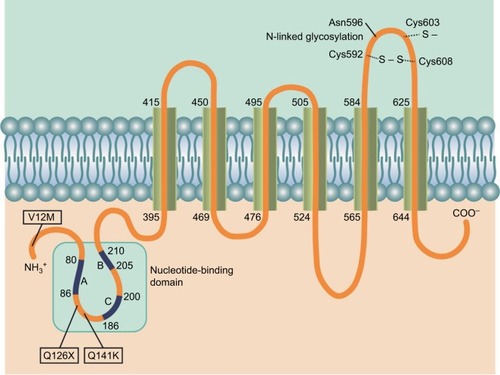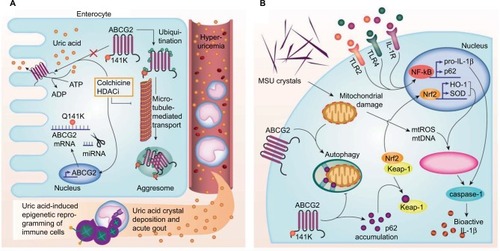Figures & data
Figure 1 Schematic representation of gout- and hyperuricemia-related polymorphisms in ABCG2. The ABCG2 protein consists of 655 amino acids and can be divided into an intracellular N-terminal domain, a nucleotide binding domain, six transmembrane domains, and a C-terminal end. The nucleotide-binding domain (amino acids 44-288) contains several signature sequences, named Walker A (A), Walker B (B), and the ABC signature sequence (C). The beginning and end amino acid position numbers are given for the signature sequences and the transmembrane domains. The third extracellular loop contains two cysteine residues connected by a disulfide bridge, and a glycosylated asparagine residue, both of which influence stability of the receptor. The cysteine residue at position 603 is important for homodimer formation. The V12M polymorphism is located in the N-terminal domain. The Q126X and Q141K polymorphisms are both located in the nucleotide-binding domain between the Walker A and the ABC signature sequences.

Figure 2 Tissue expression of ABCG2 in humans. Generated from the Genotype Tissue Expression (GTeX) database, derived from deceased people (organ and tissue donors) and surgical donors.

Table 1 Major genetic variation in ABCG2 and impact on protein expression and phenotype
Figure 3 Schematic overview of the roles of ABCG2 in hyperuricemia and gout. (A) The ABCG2 transporter is highly expressed in the gut, where it regulates ATP-dependent uric acid excretion. The 141K ABCG2 variant leads to decreased surface expression, targeting of the misfolded protein to aggresomes and proteasomal degradation. In addition, the polymorphism increases miRNA-mediated degradation of mRNA. The resulting increase in circulating urate not only increases the risk of gout but can also induce a more pro-inflammatory state in monocytes due to epigenetic reprogramming.Citation129 Colchicine and HDAC inhibitors (HDACi) can restore 141K surface expression and function. (B) Monosodium urate crystals can induce mitochondrial damage, leading to the release of mitochondrial reactive oxygen species and DNA (mtROS, mtDNA), which in turn can activate the NLRP3 inflammasome. This can be limited through autophagy-mediated clearance of damaged mitochondria. ABCG2 plays a role in this process. In defective or diminished autophagy, p62 can accumulate, bind to keap-1, and induce translocation of Nrf2 to the nucleus. Nrf2 induces transcription of heme oxygenase-1 and superoxide dismutase (HO-1, SOD), which can also induce NLRP3 inflammasome activation.

Figure 4 Meta-analysis of association of ABCG2 V12M (rs2231137) with gout: Han Chinese (China),Citation70 Han Chinese (Taiwan),Citation69 Taiwanese Aboriginal,Citation69 New Zealand Polynesian (982 cases and 941 controls), and the UK Biobank (2,422 cases and 152,249 controls). Effect is shown to the minor allele (12M). Variant rs4148153 is a surrogate marker for rs2231137 in people of Polynesian ancestry.

